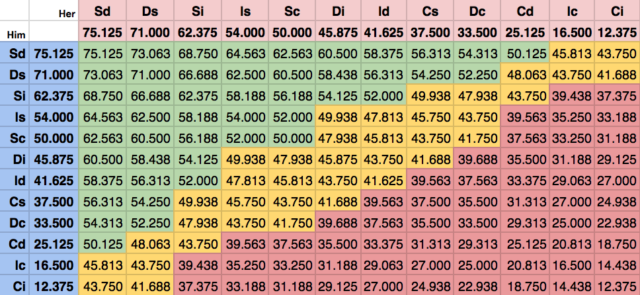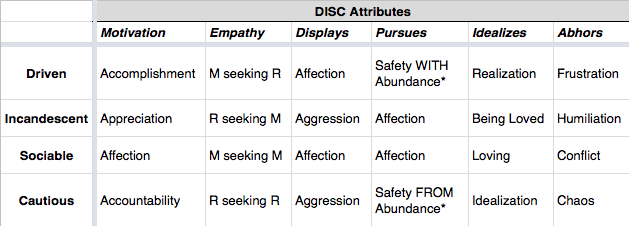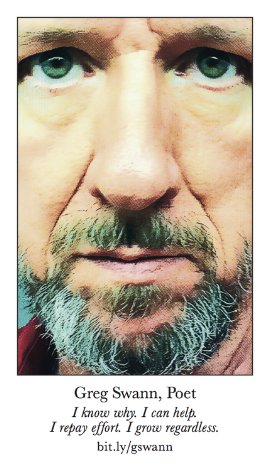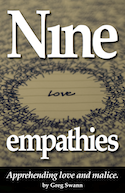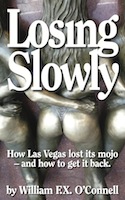
Human civilization is nothing but the answer to this one monumentally important question: How does a nice guy go about getting a second date around here?Photo by: Kevin Dooley
I’ve put all the new marriage posts into a new category, so you can read them all, if you want. I have a book here, but I have three books this Summer, plus a few movies and a lot of other stuff. I understand human motivation better than I ever have before – which means better than yesterday and much better than last week. When the rest of the world catches up, amazing things are going to happen.
How do I know that’s so?
Because I can trouble-shoot marriages – by DISC profiles.
The work we did yesterday, establishing a rank-ordering of relative sociability by DISC type, also gives us a quick tool for predicting the future concourse of relationships according to the DISC profiles of the people making them up.
Don’t call me Doctor Marriage. All I have so far are mad-scientist theories built from LegoNumbers™ – from scaled estimates of human priorities. But: Still: The fallacy of reductionism results not from reduction but reduction to the inessential. When you have reduced to the essential, what you have is not fallacy but formulae.
So: Let’s get formulaic and see if we really can map the dance of marriage.
Start where we finished yesterday, with a rank-ordering of relative sociability among DISC types:

Another heading for that chart could be “Relative Amiability” – who will be easier to get along with, going forward, in any recurring social context – marriage, home, work, play, world-at-large? Working from the bottom up, who will require special handling to keep the relationship alive?
Accordingly, yet another heading could be “Relative Marriageability” – who will be a better spouse, right out of the box and going-forward? And who, on the other hand, will always be pulling against the relationship – whether pulling inward or pulling away?
Did I just hear you say, “Oof”? We ain’t done yet.
Still another heading could be “Propensity for Blind Cooperation.” Too stuffy? How about: “Who smiles more?” Same thing, either way: Every new encounter is a Prisoner’s Dilemma. More Sociable and more Driven people will default toward the Affectionate Display – cooperation – where more Cautious and more Incandescent people will default toward the Aggressive Display – betrayal.
The ensuing display and response ping-pong – mediated on both sides by the DISC predispositions of the participants – is a transaction. Play the encounter out to multiple, concurring and parallel transactions and you have an interaction. If a new interaction among people who had been strangers recurs, that’s a relationship.
Why are we building these definitions? Because “science” typically does not. Most of the “science” of human interaction – economics, psychology, sociology, anthropology – is Ci Blinded: Deliberately self-blinded by erroneous pre-suppositions, theories and methods.
So Ci academics will typically focus on the event or the encounter or at most the one-off transaction, without considering everything else that is going on – including the multiple DISC currencies in play in any interaction, the mutually-reciprocal, mutually-profitable value exchanges occurring in those unsuspected currencies and the reservoirs of storgic love built up therefrom.
“Science” either does not know or will not admit that storgic love – the enduring love of families – even exists. Economics predicts what robots must do, then incessantly berates and derides humanity for being insufficiently reptilian. The social sciences conflate empathy with compassion, then insist human beings can somehow come into existence without empathy. Taken together, they are two mutually-contradicting maps of a place that never existed, anyway.
Every relationship has an abstract reservoir of storgic love, accumulated from past interactions. How much is a matter of opinion – the opinions of the people involved – which of course can vary, both by person and over time. Every new interaction either adds to or subtracts from that reservoir of storgic love – and this accumulation or reduction can be predicted in gross.
How? By iteratively running Prisoner’s Dilemma games – if that suits you – using the Relative Amiability of the participants to predict the likelihood of future recurring interactions. Fudge the numbers any way you like, in very short order you will understand marriage and divorce like you never have before.
Or, you could do something much more simple: Strike an average of the Relative Amiability of the two parties to a relationship – new or ongoing – and assume that numbers below 50% are not good.
Remember, these are LegoNumbers™. We are calculating among imputed DISC motivations, not measuring real people – assuming that’s even possible in a non-Ci Blinded way. Accordingly, while anecdotes contrary to probability are not evidence against those odds, odds are not destiny, either. We are inferring probable outcomes, that’s all, and the odds on any real-life human choice are easily bucked: “Just say no.”
But take a look at this garish wedding cake:
Those are amiability crosses, so you could use them to forecast any ongoing relationship, not just marriage. And most of those crosses won’t happen in marriage, anyway. Si with Si is Lesbian Bed Death even if one or both partners is enscroted. And why would a Dc marry a Cd? So he could finally get a reliable double-entry inventory of all his ammunition?
Those are funny, but op-op-opposites attract, so D and C men marry S and I women. Here is the actual comedy of marriage: Pin meets cushion. Pin penetrates cushion. Will the interaction recur?
Human civilization is nothing but the answer to this one monumentally important question: How does a nice guy go about getting a second date around here?
The answer? Ds, of course. In marriage, obviously, but in human civilizations, too, if the goal is pandemic human thriving. That is all implicit in that chart.
If you’re reading this, you are almost certainly an anecdote contrary to the odds – just like me – so we can skip the details. To DISC your marriage is to see its dance, its overarching repetitions, against which counter-examples come to fade over time. My life is Di, but my marital praxis yearns toward Ds, so my real-life marriage is better than the chart suggests it might be. Good for me, and better for me later, as I continue to work to improve my Sociability at home.
But: Still: That chart is scary, isn’t it? The higher your number, the better your marriage is likely to be – and, accordingly, the better it is likely to get over time, as your store of storgic love grows. The lower, the worse, of course.
So DISC yourself and your spouse by your most-important and second-most-important priorities. Those would be your real-life DISC types, and they are accurate to the exact extent you are truthful about your past expressions of real-life priorities. DISC is how you choose, so your DISC profile is how you have chosen.
Using your newfound shared self-knowledge, plot your marriage on the chart of marital crosses above. If you crave C-ish order, I have that chart in a pure black-and-white, easy-lookup form – but I’m not sharing that. 😉
How’d you do?
If your marriage is in the green, it doesn’t mean you’re home free, it just means you’re better – as a couple – at staying together, rather than pulling against each other. But as we saw with the horrifying marriage of Ayn Rand (Ci) to Frank O’Connor (Sd), Sociable love will find a way to stay – even when it shouldn’t.
If you’re in that sneezy goldenrod zone, what do you need to pull forward into the green? More affection, less aggression. That means every single display – most perniciously the ones to which you are both by now habituated.
My own marriage is green-and-getting-greener, but that’s because I’ve been hammering the specific words “affectionate display” into my head in every new and recurring interaction for three years now, after having worked less rigorously to be more affectionate at home for the past ten years – around the time I first started DISCing everything, as it turns out.
If your marriage is in the red zone, is it doomed? Maybe. The net outcome of the iterative interplay of the DISC profiles argues that you two are more competitive than cooperative, more apart than partnered. Each new interaction will tend to subtract from the reservoir of storgic love – residual lust (ludic, romantic love), very probably – rather than adding to it. Sporadic counter-examples – your good days – will only seem to make the everyday rancor that much worse.
This is strictly Di engineering, so follow this advice at your own risk: If you can’t fix it, get it to break. If your marriage isn’t making each of you better, it’s making both of you worse – with amplifying effects over time.
A good marriage should be making both of you better, and it should be making a better and stronger “us” of the two of you over time. Marriage is “us before anything,” and a bad marriage, for one partner or both, is “something before us.”
That’s why having C or I in the first or second position of your DISC profile can be so devastating to relationships: The farther you stray from Ds/Sd, the more likely you are to view one or more of your values as being more important to you than is the “us” of your marriage.
How will you betray your spouse and your marriage, if you do? Show me your DISC profiles. You can have all the outlier anecdotes: The odds are all my way.
That chart shows you the what, the who and the why of the modern sexual landscape – and guess what? Love is a battlefield. Most DISC strategies are Ci Blinded, de facto – too reptilian, too unilateral and too aggressive. Accordingly, so many people are so socially inept that long-term relationships of all sorts are borne on the Atlas-like shoulders of the Sociables – who break up by reconciliation.
What happens when Atlas shrugs?
Boom.
Welcome to my Summer – my best so far.
Who knows what I will have worked out by this time tomorrow?

